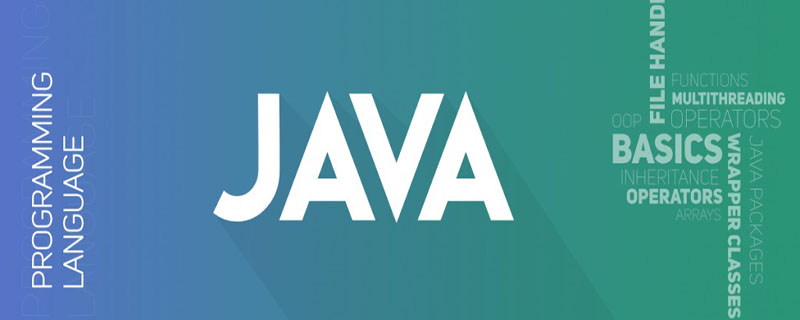what is java string
Java string is the string class, and all string literals (such as "abc") in Java programs are implemented as instances of this class. Strings are constants; their values cannot be changed after they are created. String buffers support mutable strings. Because String objects are immutable, they can be shared.

Create a string
The simplest way to create a string is as follows: (Recommended learning: java course )
String greeting = "java入门教程";
When you encounter a string constant in the code, the value here is "Rookie Tutorial", and the compiler will use this value to create a String Object.
Like other objects, you can use keywords and construction methods to create String objects.
The String class has 11 construction methods, which provide different parameters to initialize the string. For example, provide a character array parameter:
StringDemo.java file code:
public class StringDemo{
public static void main(String args[]){
char[] helloArray = { 'r', 'u', 'n', 'o', 'o', 'b'};
String helloString = new String(helloArray);
System.out.println( helloString );
}The compilation and running results of the above example are as follows:
runoob
Note: String class It is immutable, so once you create a String object, its value cannot be changed (see the notes section for details).
If you need to make a lot of modifications to the string, you should choose to use StringBuffer & StringBuilder class.
The above is the detailed content of what is java string. For more information, please follow other related articles on the PHP Chinese website!

Hot AI Tools

Undress AI Tool
Undress images for free

Undresser.AI Undress
AI-powered app for creating realistic nude photos

AI Clothes Remover
Online AI tool for removing clothes from photos.

Clothoff.io
AI clothes remover

Video Face Swap
Swap faces in any video effortlessly with our completely free AI face swap tool!

Hot Article

Hot Tools

Notepad++7.3.1
Easy-to-use and free code editor

SublimeText3 Chinese version
Chinese version, very easy to use

Zend Studio 13.0.1
Powerful PHP integrated development environment

Dreamweaver CS6
Visual web development tools

SublimeText3 Mac version
God-level code editing software (SublimeText3)
 What is a HashMap in Java?
Aug 11, 2025 pm 07:24 PM
What is a HashMap in Java?
Aug 11, 2025 pm 07:24 PM
AHashMapinJavaisadatastructurethatstoreskey-valuepairsforefficientretrieval,insertion,anddeletion.Itusesthekey’shashCode()methodtodeterminestoragelocationandallowsaverageO(1)timecomplexityforget()andput()operations.Itisunordered,permitsonenullkeyandm
 How to create and use an array in Java
Aug 11, 2025 pm 04:00 PM
How to create and use an array in Java
Aug 11, 2025 pm 04:00 PM
TocreateanduseanarrayinJava,firstdeclarethearraywiththedatatypeandsquarebrackets,theninstantiateitwiththenewkeywordorinitializeitdirectlywithvalues;1.DeclareandcreateanarrayusingdataType[]arrayName=newdataType[size];or2.InitializedirectlywithdataType
 How do you create a thread in Java?
Aug 11, 2025 pm 01:34 PM
How do you create a thread in Java?
Aug 11, 2025 pm 01:34 PM
YoucancreateathreadinJavabyextendingtheThreadclassorimplementingtheRunnableinterface.2.ExtendingThreadinvolvescreatingaclassthatoverridestherun()methodandcallingstart()onaninstance.3.ImplementingRunnablerequiresdefiningtherun()methodinaclassthatimple
 python argparse required argument example
Aug 11, 2025 pm 09:42 PM
python argparse required argument example
Aug 11, 2025 pm 09:42 PM
When using the argparse module, the parameters that must be provided can be achieved by setting required=True. 1. Use required=True to set optional parameters (such as --input) to be required. If not provided when running the script, an error will be reported; 2. Position parameters are required by default, and there is no need to set required=True; 3. It is recommended to use position parameters for necessary parameters. Occasionally, the optional parameters of required=True are used to maintain flexibility; 4. required=True is the most direct way to control parameters. After use, the user must provide corresponding parameters when calling the script, otherwise the program will prompt an error and exit.
 What are comments in Java?
Aug 12, 2025 am 08:20 AM
What are comments in Java?
Aug 12, 2025 am 08:20 AM
CommentsinJavaareignoredbythecompilerandusedforexplanation,notes,ordisablingcode.Therearethreetypes:1)Single-linecommentsstartwith//andlastuntiltheendoftheline;2)Multi-linecommentsbeginwith/andendwith/andcanspanmultiplelines;3)Documentationcommentsst
 How to use request parameters in Java with Spring Boot
Aug 11, 2025 pm 07:51 PM
How to use request parameters in Java with Spring Boot
Aug 11, 2025 pm 07:51 PM
In SpringBoot, the methods for processing request parameters include: 1. Use @RequestParam to obtain query parameters, which supports required, optional and default values; 2. Receive multiple parameters of the same name through List or Map type; 3. Bind multiple parameters to the object in combination with @ModelAttribute; 4. Use @PathVariable to extract variables in the URL path; 5. Use @RequestParam to process form data in POST request; 6. Use Map to receive all request parameters. Correct selection of annotations can efficiently parse requested data and improve development efficiency.
 The Best IDEs for Java Development: A Comparative Review
Aug 12, 2025 pm 02:55 PM
The Best IDEs for Java Development: A Comparative Review
Aug 12, 2025 pm 02:55 PM
ThebestJavaIDEin2024dependsonyourneeds:1.ChooseIntelliJIDEAforprofessional,enterprise,orfull-stackdevelopmentduetoitssuperiorcodeintelligence,frameworkintegration,andtooling.2.UseEclipseforhighextensibility,legacyprojects,orwhenopen-sourcecustomizati
 How to use the HttpClient API in Java
Aug 12, 2025 pm 02:27 PM
How to use the HttpClient API in Java
Aug 12, 2025 pm 02:27 PM
The core of using the JavaHttpClientAPI is to create an HttpClient, build an HttpRequest, and process HttpResponse. 1. Use HttpClient.newHttpClient() or HttpClient.newBuilder() to configure timeouts, proxy, etc. to create clients; 2. Use HttpRequest.newBuilder() to set URI, method, header and body to build requests; 3. Send synchronous requests through client.send() or send asynchronous requests through client.sendAsync(); 4. Use BodyHandlers.ofStr







